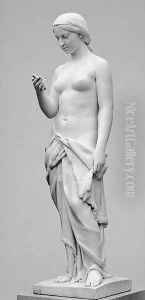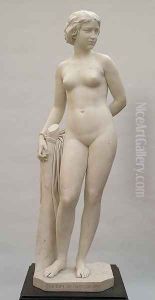Erastus Dow Palmer Paintings
Erastus Dow Palmer was an American sculptor born on April 2, 1817, in Pompey, New York. He began his artistic career as a carpenter and a cameo cutter. His interest in sculpture was sparked by his work with cameo portraits, after which he transitioned to carving in marble. Palmer was self-taught, never having studied in Europe like many of his contemporaries. Despite this, he achieved considerable success and recognition in the United States.
In the 1850s, Palmer's career in sculpture began to flourish. He became known for his idealized bas relief portraits and his full-length figure sculptures. One of his most famous works is the 'White Captive' (1857), which reflects the neoclassical style that was popular during his time. His subjects often included women and children, portrayed with a sense of purity and sentimentality.
Palmer's work was part of the artistic movement known as the American Renaissance, which took place from around 1876 to 1917. His sculptures were notable for their refined execution and graceful forms. He was based in Albany, New York, where he established a successful studio. Notable among his patrons was the wealthy Albany businessman Erastus Corning, who commissioned several works from Palmer.
Despite his lack of formal training, Palmer's skill and artistry earned him a place among the respected American artists of the 19th century. He was a member of the National Academy of Design and received numerous accolades throughout his career. Palmer's legacy is significant in that he was one of the early American sculptors to achieve both national and international recognition without having studied abroad, which was quite rare for the time.
Palmer died on March 9, 1904, in Albany, New York. His works continue to be studied and appreciated for their contribution to American neoclassical sculpture and the wider cultural milieu of the 19th century.



